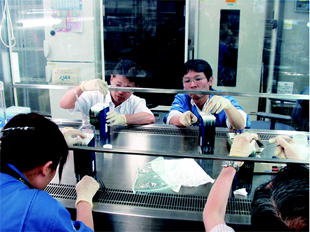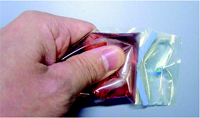This is an archive of information released in the past.
Disclaimer: It may contain broken links or outdated information. Some parts may not function in current web browsers.
*Visit https://humans-in-space.jaxa.jp/en/ for the latest information.

Experiment
- News
- Kibo Utilization Strategy
- Kibo Utilization Plan
- List of JAXA's Utilization Themes
- Experiment Facilities
- Space Environment Utilization
- Archive
A study into the functions of the tumor suppressor p53 gene in space
Gene Expression of p53-regulated Genes in Mammalian Cultured Cells after Exposure to Space Environment
Rad Gene
Background
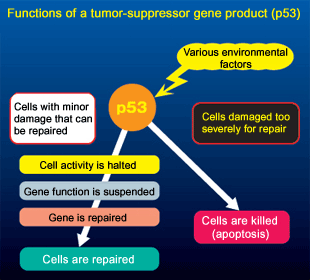
Figure 1. Functions of tumor-suppressor gene product p53

Figure 2. Amounts of p53 in muscle of rats after a space flight
About 3.5 times more p53 had accumulated in the muscle of four rats after a space flight on a space shuttle in 1993 than in the muscles of rats on Earth.
One of the effects of radiation on the human body is cancer formation due to failure of DNA to be repaired properly after damage.
Once normal cells turn into abnormal cells because of gene mutation, they grow excessively, resulting in cancer. Cancer infiltrates surrounding normal cells and tissues and has fatal effects on the body. Cancer research on Earth has been developing dramatically. In cancer cells in cancer patients, the gene called p53 is often found to be abnormal, which makes p53 a key gene in cancer research (Figure 1).
Professor Takeo Ohnishi found that p53 protein had accumulated in the muscle and skin of rats after a space flight on the Space Shuttle Columbia in 1993 (Figure 2). This p53 protein is the focus of this experiment.
Objective
p53 plays many roles, such as inhibiting cell growth and initiating the programmed cell death (apoptosis). The way in which the cell progresses (the cell’s destiny) is determined by which gene has received a signal from p53 protein. If p53 functions so that cell growth is inhibited, damage to the gene of the cell can be repaired during the inhibition. p53 can also eliminate abnormal cells by initiating apoptosis and leading them to death and, as a result, stop cancer formation. This is why the p53 gene is called a tumor-suppressor gene.
The accumulation of p53 protein in the muscle and skin of rats after a space flight may have been due to the function of p53, which might have sensed a change in cells in space as on Earth. In humans as well, p53 may function to protect cells against the radiation environment in space.
In this space experiment, cells will be brought into space to find out how the p53 gene functions and acts on other genes. If its functions are understood, they, in association with p53 research on Earth, will illustrate the reaction of cells when they are damaged in the space environment and help develop methods of radioprotection for the maintenance of health during long-term stays in space.
Outline of the Experiment
Human lymph cells will be frozen and launched. Two types of cells will be used: cells with normal p53 (TK6, with normal p53) and cells with abnormal p53 (WTK1, with mutant p53).
The frozen cultured cells will be thawed in space and incubated in the microgravity compartment and the 1G compartment for about one week. Then, the cells will be frozen again and brought back to Earth. During the experiment period, the amount of radiation in space will be measured.
After the cells are recovered on Earth, expressions of the genes and protein related to p53 will be evaluated to analyze the functions of the p53 gene in space.
This is the Point!
Professor Ohnishi has been conducting experiments on the relationships between radiation and living organisms since Japan started experiments on Space Shuttles in the 1990s. Based on his experience, he argues about radiation that it is important to “have precise knowledge and appropriate concern.” In other words, we should have accurate information and take appropriate measures, rather than being unnecessarily frightened.
The bodies of living organisms consist of amazing systems. It is known that even if cells are damaged by an increased exposure to radiation in space, p53 and other genes work properly to suspend cell division, repairing damaged genes or inducing apoptosis to cells that are damaged too severely for repair in the meantime; thus, organisms can eliminate radiation damage.
If we understand these functions precisely, we will not have to be overly frightened of radiation.
“Precise knowledge” of the functions of genes, primarily the p53 gene, in space will be the first step to research into protective measures against space radiation, which will help us when we try to travel to the moon and Mars, and even further.
The original cell culture bag is full of innovation
The cell culture bag is divided in two chambers. Chamber A contains frozen cells and a culture medium while chamber B contains a chemical-added culture medium to be used when cells are frozen after incubation in space. The bag will be frozen with the two chambers separate when it is launched. The cells will be incubated in space. At the completion of incubation, an astronaut will mix the solutions in chambers A and B. The partition between the chambers is devised so that it can be removed easily when pressure is applied from one side (see picture). The chambers A and B contain beads, one in each, which are to indicate that the solutions have been mixed thoroughly. After the solutions are mixed, they will be frozen and recovered on Earth.
What is the difference between p53 and p53?
Since blueprints for protein production are contained in genes, genes and proteins often appear in pairs in expository explanations . The protein that gene “a” produces is often called “a.” If something is called “a” in expository explanations , it may not be clear whether it refers to the gene or the protein. Therefore, in life science, italic letters like “a” are used to refer to genes while regular letters like “a” are used to refer to proteins.
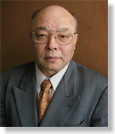 |
Principal Investigator Takeo Ohnishi Professor, Nara Medical University School of Medicine |
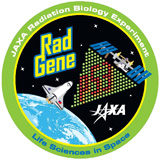 |
| Copyright 2007 Japan Aerospace Exploration Agency | Site Policy |
